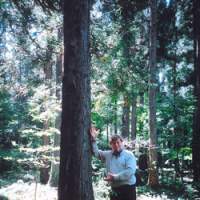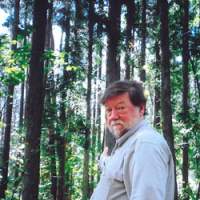According to figures given to me by the Tokyo Metropolitan Government, about 16 percent of people living in Japan suffer an allergic reaction to pollen from Japanese cedars (Cryptomeria japonica). In the Greater Tokyo area this increases from one-in-six to an astonishing one-in-four people. The very uncomfortable reaction -- called kafunsho in Japanese (kafun means "pollen"; sho means "syndrome" or "ailment") -- is very similar to what is widely known as hay fever, with typical symptoms including sneezing, a runny nose, sore eyes and sometimes headache.
Well, just last month I was elected to be a vice chairman of a 26-member committee to discuss and propagate measures to combat this allergy. The committee's name translates as "Movement for Forests with Less Pollen," and it was brought into being by direct order of the Governor of Tokyo, Shintaro Ishihara who, I believe, is a sufferer himself.
One of the medical doctors on the committee, an expert on environmental health, said that in Japan, 20 billion yen a year is spent on treatment of this cedar-pollen allergy. The Tokyo government is coming up with a budget of 3,450 million yen this year to start to try and tackle the problem. To begin with, it will promote a method of alleviating the symptoms with some sort of pollen extract pill placed under the tongue. They also intend to conduct an extensive survey in Tokyo to try to assess the scale and scope of the problem, and to introduce automatic measuring systems to forecast a pollen "bloom."
Meanwhile, long-term measures include the felling of 12,000 hectares of cedar plantations, and one of the official proposals is to replace them with low-pollen cedars.
I have discussed this matter at length with Mr. Matsuki, the forester at our Afan Woodland Trust up here in the Nagano Prefecture hills. He says that locally we do have cedars (which he calls kuma sugi, meaning "bear cedars") that can grow to a massive size but give off far less pollen than the varieties normally grown in cedar plantations. He says that the heartwood is blackish in color, and not so popular.
But the forestry authorities as a whole should think in broader, more diversified terms.
For years I have not only suggested, but experimented in our own woods with trimming out about half of the spindly cedar trees to let in more light and so give the ones left a chance to flourish. I advocate changing the majority of Japan's untended, monocultured cedar woods to mixed woodlands of conifers, broad-leafed trees and shrubs -- which is what the forests of Tokyo were like until about 100 years ago.
Recreational healing
Altering the forestry makeup in this way will improve the thickness and quality of the remaining cedar trees, greatly reduce the amount of cedar pollen released, improve wildlife habitat and increase the ability of the forest to hold water (and give us better water too, because broad-leaf humus is a marvelous natural filter). Mixed forests also yield lots of mushrooms, wild edible plants, berries and medicinal plants. They have greater healing properties, too, when used for recreation.
It will be very important to the success of any such initiatives that the cedar-felling generates incomes and revenue. So far, the ideas put forward include making desks and lockers for public schools from the lumber, and generally encouraging the use of Japanese cedar in local construction.
Currently, it is proposed to start cutting down cedar trees this autumn, at a rate of 1,200 hectares per year for 10 years.
There will be a lot of road construction involved in this, and in Japan, that always worries me. Construction companies will froth at the mouth and come up with enormously expensive plans to make hard, wide roads for very heavy equipment. These roads are an ecological disaster and cost a hell of a lot to maintain.
Instead, I advocate a network of narrower roads with rain-absorbing surfaces and laybys for four-wheel-drive vehicles to pass. I consider that the ideal logging road should not be visible from the air when the leaves are on the trees. Such roads, when not in use for extraction operations, would, or could, provide paths for hikers, cyclists, horses or whatever. Also, the gathering areas for cut timber can be used as campsites or picnic grounds when they are not piled high with lumber. They could then be plowed up when logging operations have moved on and treated to make areas for growing tree saplings.
E-mail invitation
There are many problems and arguments surrounding this whole issue, and if any readers have ideas you would like to get straight to the committee, please e-mail [email protected]. My long-suffering editor will see that I receive the printouts, though for any reply I would need to have your "snail mail" address. (Long-suffering Ed's note: Old Nic determinedly "doesn't do" e-mail -- or possess a cellular phone.)
Although I am genuinely sympathetic to pollen-allergy sufferers, in Japan the problem has arisen mainly due to 30-odd years of neglect, if not negligence, coupled with very short-sighted government forestry policies. An American forester told me, and Mr. Matsuki heartily agrees, that when whole areas of cedars stop growing healthily, then they somehow sense a need to ensure that they leave descendants. Consequently, they produce masses of pollen.
| * * * * * |
Another symptom of this neglect, and another cause of airborne pollen allergy, is all the neglected grazing land and meadows that have been taken over by hogweed. This member of the chrysanthemum family originated in North America, and larger varieties of the vigorous weed can grow three meters high.
Our back yard here in Kurohime used to face out onto a meadow, but since the farmer stopped feeding his cattle hay, and switched to American feed, the meadow has become an impenetrable jungle of hogweed that we have to fight back against so that it doesn't swallow us. If he'd have cut his field just twice a year, this would not have happened. As it is, even if American feed became so expensive that he decided to go back to hay, or to grow grain himself, his land is useless now and it would take an enormous effort to try to undo the harm done.
Where has pride in the land gone?
| * * * * * |
While I was writing this piece, Mr. Matsuki came to the house, bringing a marvelous clump of Hen of the Woods mushrooms. These are called maetake (meaning "dancing mushrooms") in Japanese, and they are absolutely delicious. They can be cultivated, but the cultivated ones taste nowhere near as good as the wild ones. Maetake usually grow in the wild at the foot of old Mongolian oak trees which have started to rot on the inside, but are still alive and seemingly healthy on the outside. You have to have old-growth forest for this.
Again, though, the Forestry Agency has come up with yet more plans to cut vast areas of old-growth forest here in Japan in order to pay their own salaries. As has been their wont, they'll probably replant with cedars.
If anybody could ever convince me of the sense of it all, I would be grateful -- but ever dubious.





















With your current subscription plan you can comment on stories. However, before writing your first comment, please create a display name in the Profile section of your subscriber account page.